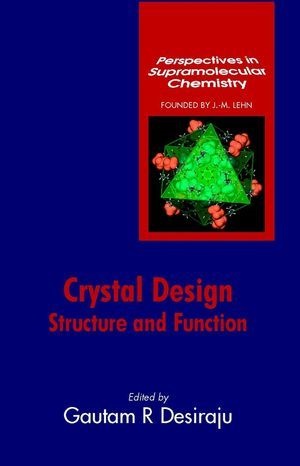Read more
Informationen zum Autor Gautam Radhakrishna Desiraju is an Indian chemist who has contributed substantially to the themes of crystal engineering and weak hydrogen bonding. He has authored books on these subjects. He has co-authored a textbook in crystal engineering. Klappentext Perspectives in Supramolecular Chemistry relates recent developments and new exciting approaches in supramolecular chemistry. The series covers al areas from theoretical and modelling espects through organic and inorganic chemistry and biochemistry to materials, solid-state and polymer sciences reflecting the many and varied applications of supramolecular structures in modern chemistry. Crystal engineering is one of the fastest growing areas in supramolecular chemistry because it is able to define design strategies that link structure with properties of useful solids. Crystal Design is the first book that emphasises this continuity between what a crystal is and what a crystal can do. Written by experts, this book establishes connections between the structures of molecular materials and their properties and links the domains of intermolecular interactions, crystal structures and crystal properties. Without interactions there cannot be structures, and without worthwhile properties as a goal, there cannot be sufficient reason for designing structures. The many advances that have been made during this process are described in this book. Crystal Design follows on from an earlier volume in the series entitled The Crystal as a Supramolecular Entity. While the earlier volume was conceptual in its theme, this volume concerns methodology and practice, the nuts-and-bolts of crystal engineering. Among the topics covered are network structures, hydrogen bonds as design elements, microporous solids, polymorphism, ferromagnetism and sensors. The systems described cut across traditional organic and inorganic divisions of chemistry. Zusammenfassung One of the major applications of supramolecular chemistry is the design of solids with specified properties. Crystal design is the interface between supramolecular design chemistry, crystallography and materials science. Inhaltsverzeichnis Contributors. Preface. 1. Hydrogen Bonds in Inorganic Chemistry: Application to Crystal Design (Lee Brammer). 2. Molecular Recognition and Self-Assembly Between Amines and Alcohols (Supraminols) (Raffaele Saladino and Stephen Hanessian). 3. Very Large Supramolecular Capsules Based on Hydrogen Bonding (Jerry L. Atwood, Leonard J. Barbour and Agoston Jerga). 4. Molecular Tectonics: Molecular Networks Based on Inclusion Processes (Julien Martz, Ernest Graf, André De Cian and Mir Wais Hosseini). 5. Layered Materials by Design: 2D Coordination Polymeric Networks Containing Large Cavitities/Channels (Kumar Biradha and Makoto Fujita). 6. The Construction of One-, Two- and Three-Dimensional Organic-Inorganic Hybrid Materials from Molecular Building Blocks (Robert C. Finn, Eric Burkholder and Jon A. Zubieta). 7. A Rational Approach for the Self-Assembly of Molecular Building Blocks in the Field of Molecule-Based Magnetism (Melanie Pilkington and Silvio Decurtins). 8. Polymorphism, Crystal Transformations and Gas-Solid Reactions (Dario Braga and Fabrizia Grepioni). 9. Solid-Gas Interactions Between Small Gaseous Mole cules and Transition Metals in the Solid State. Toward Sensor Applications. (Michel D. Meijer, Robertus J. M. Klein Gebbink and Gerard van Koten). Cumulative Author Index. Cumulative Title Index. Index. ...

